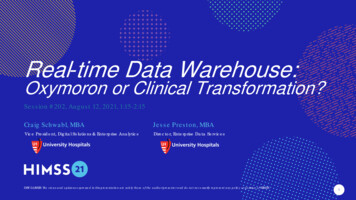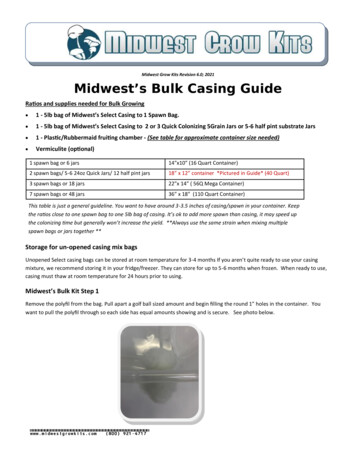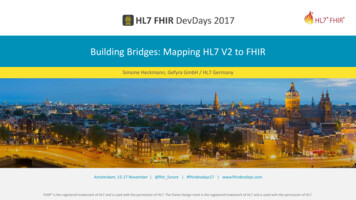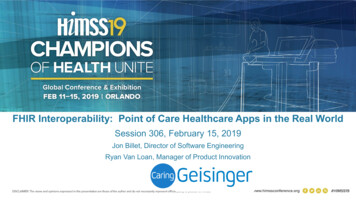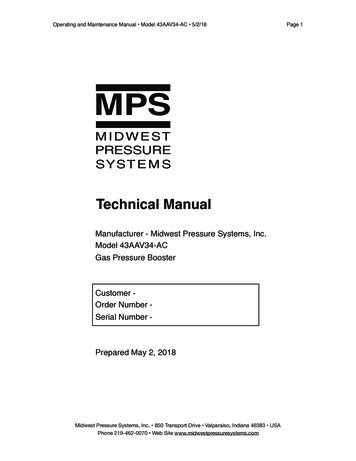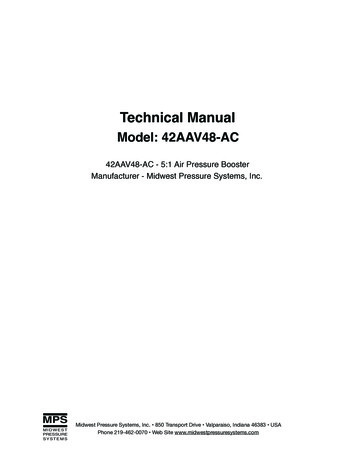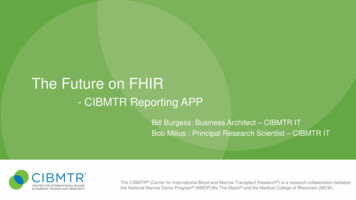
Transcription
The Future on FHIR- CIBMTR Reporting APPBill Burgess: Business Architect – CIBMTR ITBob Milius : Principal Research Scientist – CIBMTR ITThe CIBMTR (Center for International Blood and Marrow Transplant Research ) is a research collaboration betweenthe National Marrow Donor Program (NMDP)/Be The Match and the Medical College of Wisconsin (MCW).
Overview Who we are and what we do.Outline the current data collection and its challenges.Introduce HL7 FHIR Resources.The CIBMTR Reporting App for Epic using FHIR.Where we are headed next.2
Our mission:We save lives through cellular therapy3
What we do? For those suffering from a blood cancer like leukemia orlymphoma or those suffering from a blood disease like sicklecell anemia a cure exists. Most of these patients are in need ofa blood stem cell transplant from either a related or unrelateddonor. For those who do not have a match in their family theyturn to Be The Match.Be The Match operates the world’s largest and most diversevolunteer donor registryBe The Match facilitates transplants by 3 different types of cellsources– Marrow– Peripheral Blood Stem Cells (most common)– Umbilical Cord BloodSince 1987 BTM has helped facilitate more than 97,000transplantIn 2019 we facilitated nearly 6,600 transplants4
Our Network5
NMDP/BeThe MatchEstablishedoutcomes registryand researchrepository in 1986MedicalCollege ofWisconsinEstablishedoutcomes registry in1972; NIH fundedsince 1985The CIBMTR is a researchcollaboration betweenNMDP/Be The Match and theMedical College of Wisconsin6
Research7
Research Data FlowNMDP /Be the MatchResearchMatching Patientswith DonorsTransplantCenterCIBMTROutcomes8
Numbers of Patients Reported by YearTransplant EssentialData (TED)ComprehensiveReport Forms(CRF only)Cellular TherapyTransplant EssentialData 25,3405,0891,0722018*19,6104,546815*Patients continue to be registered for 2018; Data are incomplete9
Completed Forms 2017-2019*10
HighLevelOverviewTransplantCenter DBTransplantCenter UI(s)Etc.External LabsPhysicianInternalLabsEHRFormsNet GNISServiceTransplantCenterCIBMTRCurrent racts11
The Problem We Are Trying To Solve Data Managers are not medical experts but have to interpret the data Data is often found in federated systems– Transplant centers store the same data in different systems and formats– EHR, transplant databases, Lab systems We expect more and more complex data, e.g. molecular sequences. Mapping burden - mapping center data points to CIBMTR forms for electronicdata submission is time consuming. Form Revisions – Forms are frequently changing to keep up with science12
How Do We Attack This Problem Use of widely accepted health care standards for exchangingdata Standards that are supported by existing healthcareapplications, e.g.: EHRs Collect data that are mapped to establish healthcarestandards, LOINC, SNOMED, caDSR We don’t want to reinvent the wheel13
Health Care Related Standards14
HL7 FHIR and Resource ExamplesThe CIBMTR (Center for International Blood and Marrow Transplant Research ) is a research collaboration betweenthe National Marrow Donor Program (NMDP)/Be The Match and the Medical College of Wisconsin (MCW).
Health Level 7 International Non-profit, ANSI-accredited healthcare Standards DevelopingOrganization (SDO) “HL7 provides standards for interoperability that improve caredelivery, optimize workflow, reduce ambiguity and enhanceknowledge transfer among all of our stakeholders, includinghealthcare providers, government agencies, the vendorcommunity, fellow SDOs and patients”16
HL7 asked a question.What would healthcareexchange look like if westarted from scratch usingmodern approaches?17
Newest standard FREE! History––––2011 Proposed2012 First version2017 Standard for Trial Use 32018 Release 4 Normative Aligns with REST services– XML, JSON Active Testing– Three Connectathons a year– 22nd in Sep 2019 (7 yrs) Immense interest– Argonaut vendor initiated project Epic, Cerner, MEDITECH, Athena, McKesson,Mayo, Intermountain, Partners, etc.– ONC Sync For Science Sync For Genes– ASCO workshops18
Federal Government Rules for Consumer AccessSource:19
HL7 FHIR is used by.Project Argonaut“The purpose of the Argonaut Project is to rapidly developa first generation FHIR-based API and Core Data Servicesspecification to enable expanded information sharing forelectronic health records and other health informationtechnology based on Internet standards and architecturalpatterns and c-cerner-others-join-hl7-project20
So what exactly is FHIR?21
Resources “Resources” are:––––––The "R" in "FHIR"Small logically discrete units of exchangeDefined behaviour and meaningKnown identity / locationSmallest unit of transaction“of interest” to healthcare22 2015 HL7 Int’l. Licensed under Creative Commons. HL7, Health Level Seven, FHIR & flame logo are registered trademarks of Health Level Seven International. Reg. U.S. TM Office.
What’s a Resource?ExamplesNon-examples Administrative Gender– Patient, Practitioner, Organization, Location,Coverage, Invoice Clinical Concepts– Too small Electronic Health Record– Too big– Allergy, Condition, Family History, CarePlan, Observation, Specimen,DiagnosticReport Infrastructure– Document, Message, Profile, Conformance Blood Pressure– Too specific Intervention– Too broad100-150 total - on-to-fhir-new-zealand-seminar
st.html24
PatientResourceStructure25
PatientResourceStructure26
Simple example: Patient.xml Patient xmlns "http://hl7.org/fhir" name family value "Storm"/ given value "John"/ /name identifier system value "http://mynamespace"/ value value "123"/ /identifier gender value "male"/ birthDate value "1974-12-25"/ /Patient 27
The Solution :- Take advantage of EHR’s FHIR APIThe CIBMTR (Center for International Blood and Marrow Transplant Research ) is a research collaboration betweenthe National Marrow Donor Program (NMDP)/Be The Match and the Medical College of Wisconsin (MCW).
EHR Vendor FHIR API Capabilities29
Current StateData transmission protocols between Transplant Centers (TCs) and CIBMTRhas not kept pace with the changing technological landscape of healthcareinformatics. GOAL: a production-ready solution for electronic submission of patient data to CIBMTR.– Includes patient demographics and Graft Versus Host Disease (GVHD) information. Majority of TCs use the EPIC EHR software product.–Leverage the EPIC supported "App Orchard" functionality to integrate with the EPIC system. EPIC App Orchard enables third party partners to create "add-on" applications that integratewith the EPIC EHR product.– Authorized third party apps can access authorized patient data in their EHR via FHIR specification. CIBMTR Reporting App, after installation an authorized TC user can leverage the App toelectronically submit patient data to CIBMTR via the industry standard FHIR format.30
CIBMTR Reporting App A new messaging interface using healthcare informatics standards(HL7 FHIR) that embraces modern approaches to data exchange. Reduces data submission burden for centers by introducing greaterinteroperability between CIBMTR and transplant center EHR solutions& HLA Laboratory systems. 2019 - Expanding Proof of Concept Application to:– Exchange patient demographic and assign unique CRID– Exchange aGVHD (Acute Graft Versus Host Disease) data– Exchange recipient HLA typing31
OpenEpic & FHIR Founding member of ArgonautProject Integral FHIR Server in all currentinstallations https://open.epic.com/Interface/FHIR32
Epic App Orchard Identify mappings of CIBMTRpatient data to FHIR resource Using these mappings, develop afree Epic App for transplantcenters to collect Patientdemographic data to report toCIBMTR Mappings are public, and may beapplied to other EHRs https://apporchard.epic.com/33
34
HighLevelOverviewTransplantCenter DBTransplantCenter UI(s)Etc.External LabsPhysicianInternalLabsEHRFormsNet atorAGNISClientCIBMTR ReportingFHIR ClientAGNISServiceCurrent systemsAGNISCIBMTR ReportingFHIR New for this proposalCIBMTR35
36
Key ComponentsComponentDescriptionCIBMTR Reporting App(Browser-based)EPIC compliant App to access the EHR patient data via the FHIR interface.Submits Patient Data to the CIBMTR hosted EHR App Backend server.CIBMTR EHR AppBackend serverEHR App Backend server accepts submission requests from the Browser-basedEpic FHIR Client, validates user credentials and performs fine-grainedauthorization.FHIR ServerIndustry standard FHIR server for staging of patient demographic and GVHDdata. Supports the transfer of FHIR resources from Epic's FHIR interface to theCIBMTR's FHIR API.Patient TranslatorService to accept Patient information and make calls to FN3 Core application todetermine if patient and exists or if they need to be registered as a new patient.FHIR to FN3 TranslatorComponent that monitors the FHIR Server newly submitted FHIR Resource.converts FHIR resources to FN3 Objects and communicates to the FN3 CoreAplication.37
TechnologyTechnology DescriptionJavaNMDP supported open source language. Javawas selected because we believed we would bebetter be able to implement security features.AngularNMDP preferred open source language for javascripting is Angular 7 Javascript platform.Spring Boot NMDP preferred Microservice StandardMySQLAmazon RDS MySQL, which is the Amazondatabase service leveraged by other existingapplications.DockerDelivers a repeatable technology stack regardlessof server platform.JustificationUsed for the prototypes, socontinue to leverage for theproduction solution.Angular 7 is the latest version ofthe Angular platform.Licensing costs are prohibitivefor leveraging Oracle in AWSApplication Idempotence.38
Security Considerations Reporting App obtains credentials when logging into CIBMTRidentity provider. FHIR security labels assigned to all resources based on usercredentials General Data Access Policy– Limited based on CIBMTR user credential; only see data for centerthat user has been granted access. Redaction of Patient Identifiable Information (PII) that is notneeded to support application functionality.39
User login to CIBMTR/NMDP.The user is required to have a FormsNet username and password.40
Information is displayed about current patient selected in the Epic system. The CRID is displayed if thepatient is already registered with CIBMTR. If not, the patient may be registered by clicking on Register.
The patient has been registered and the assigned CRID is shown.
After clicking on the Details button, a summary of acute GVHD data is grouped by observation code.Individual observations may be displayed by clicking on Show. All observations may displayed by clicking on Expand All.
Where We Are Headed Increase transplant center adoption of reporting App.Improve user interface and user experience in the App.Add to the number of supported FHIR Resources.Developing App’s for other EHRs.Investigate more ways of ingesting real world data.44
Summary Who we are and what we do.Outlined the current data collection challenges.Introduced HL7 FHIR Resources.Creation the CIBMTR Reporting App for Epic using FHIR.Where we are headed next.45
Questions46
AppendixThe CIBMTR (Center for International Blood and Marrow Transplant Research ) is a research collaboration betweenthe National Marrow Donor Program (NMDP)/Be The Match and the Medical College of Wisconsin (MCW).
The CIBMTR (Center for International Blood and Marrow Transplant Research ) is a research collaboration between the National Marrow Donor Program (NMDP)/Be The Match and the Medical College of Wisconsin (MCW). The Future on FHIR - CIBMTR Reporting APP Bill Burgess: Business Architect -CIBMTR IT Bob Milius : Principal Research Scientist -CIBMTR IT



